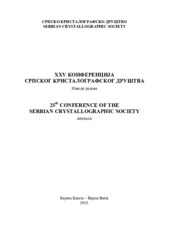Prikaz osnovnih podataka o dokumentu
Phase transition from nanostructured titania to layered titanаte
| dc.creator | Simović, Bojana | |
| dc.creator | Dapčević, Aleksandra | |
| dc.creator | Zdravkovic, Jelena | |
| dc.creator | Branković, Goran | |
| dc.date.accessioned | 2023-08-22T09:24:28Z | |
| dc.date.available | 2023-08-22T09:24:28Z | |
| dc.date.issued | 2018 | |
| dc.identifier.isbn | 978-86-912959-4-3 | |
| dc.identifier.issn | 0354-5741 | |
| dc.identifier.uri | http://rimsi.imsi.bg.ac.rs/handle/123456789/2092 | |
| dc.description.abstract | The environmental friendly titanium-based nanomaterials such as titania and titanates are often used in industry regarding to their extraordinary properties: biological and chemical stability, photocatalytic activity, cost-effectiveness. Among other procedures, the hydrothermal process became a very important way to synthesize the titania and titanate nanostructures. In this work, nine products were obtained by modifying the experimental conditions (6, 12 and 18 h at 110, 135 and 160 °C) of hydrothermal treatment of starting nanoanatase in alkaline medium (5 mol dm–3 NaOH solution). The possibility to obtain the single titanate phase was investigated as well as the influence of different experimental conditions on structural and microstructural properties of obtained products. As shown by XRPD and TEM, when commercial nanoanatase is hydrothermally treated, the single titanate phase was obtained after energetically the most intensive treatment i.e. 18 h at 160 °C. Among all other eight products, a certain amount of anatase remained, with the decreasing content as the temperature and time of hydrothermal treatment increases. This intensification of hydrothermal treatment significantly increases the solubility of TiO2 promoting the changes in morphology from nearly spherical anatase particles to elongated titanate nanosheets. This is the consequence of Ti−O−Ti bonds breaking and formation of Ti–O–Na or Ti–OH bonds and thus the growth of lamellar structures giving the complete transformation of anatase nanoparticles into titanate nanosheets after 18 h at 160 °C. The calculated unit cell parameters of this titanate phase, a = 18.188(6), b = 3.7669(3), c = 2.9812(6) Å, show the slight elongation along a-axis comparing to H2Ti2O5·H2O (PDF #47-0124). This could be explained by partial Na+ –H+ ion exchange. Based on EDS and TG of obtained pure titanate, the Na0.4H1.6Ti2O5·H2O formula could be assigned to the titanate phase. The FTIR and TG analyses showed the hygroscopic nature of Na0.4H1.6Ti2O5·H2O nanosheets and the consequential surface adsorption of water. However, the HRTEM/SAED revealed the shortening of interplanar distances along a because of the dehydratation due to vacuum and electron radiation during the TEM analysis additionally confirming the layered structure of obtained titanate. This work describes a simple synthetic procedure for production of titanate nanosheets useful for diverse applications but also finally distinguish the titanates from titania in terms of structure and microstructure. | sr |
| dc.description.abstract | Ekološki nanomaterijali kao što su titan-dioksid i titanati često se koriste u industriji zbog njihovih izvanrednih svojstava: biološke i hemijske stabilnosti, fotokatalitičke aktivnosti, ekonomičnosti. Pored drugih postupaka, hidrotermalni proces postao je veoma važan metod za sintezu nanostrukturnih titan-dioksida i titanata. U ovom radu, devet proizvoda dobijeno je variranjem eksperimentalnih uslova (6, 12 i 18 h na 110, 135 i 160 °C) hidrotermalnog tretmana polaznog nanoanatasa u alkalnoj sredini (5 mol dm–3 rastvora NaOH). Ispitana je mogućnost za dobijanje titanatne faze kao i uticaj različitih eksperimentalnih uslova na strukturna i mikrostrukturna svojstva dobijenih proizvoda. Kao što je pokazano XRPD-om i TEM-om, čista titanatna faza nastaje nakon najintenzivnijeg hidrotermalnog tretmana, tačnije nakon 18 h na 160 °C. Kod ostalih osam proizvoda zaostaje određena količina anatasa, pri čemu se ona smanjuje sa porastom temperature i dužine trajanja hidrotermalnog tretmana. Naime, intenziviranje hidrotermalnog tretmana znatno povećava rastvorljivost TiO2 dovodeći do promena u morfologiji od približno sfernih čestica anatasa do izduženih titanatnih nanopločica. Ovo je posledica raskidanja veza Ti−O−Ti i stvaranja novih veza Ti–O–Na ili Ti–OH pa samim tim i rast lamelarnih struktura, čime dolazi do transformacije nanočestica anatasa u titanatne nanopločice.Transformacija je potpuna nakon 18 h na 160 °C. Izračunati parametri jedinične ćelije ove titanatne faze a = 18,188(6), b = 3,7669(3) i c = 2,9812(6) Å pokazuju blago izduženje duž a-ose u poređenju sa H2Ti2O5·H2O (PDF #47-0124). Ovo bi se moglo objasniti delimičnom jonskomizmenom Na+ –H+ . EDS i TG analizama dobijenog čistog titanata utvrđeno je da je njegova najverovatnija formula Na0,4H1,6Ti2O5·H2O. FTIR i TG analize pokazale su da nanopločice Na0,4H1,6Ti2O5·H2O apsorbuju vodu po površini te su potvrdile higroskopnu priroduovog titanata. Međutim, HRTEM/SAED je pokazao smanjenje međuslojnog rastojanja duž a-osezbog dehidratacije usled vakuuma i elektronskog zračenja tokom TEM analize dodatno potvrđujući slojevitu strukturu dobijenog titanata. Ovaj rad opisuje jednostavan sintetski postupak za dobijanje titanatnih nanopločica korisnih za razne primene, a takođe konačno objašnjava razliku između titanata i titandioksida sa stanovišta strukure i mikrostrukture. | sr |
| dc.language.iso | en | sr |
| dc.publisher | Serbian Crystallographic Society, Belgrade, Serbia | sr |
| dc.relation | info:eu-repo/grantAgreement/MESTD/Integrated and Interdisciplinary Research (IIR or III)/45007/RS// | sr |
| dc.rights | openAccess | sr |
| dc.source | 25nd Conference of the Serbian Crystallographic Society, Bajina Bašta, Serbia | sr |
| dc.subject | Anatase | sr |
| dc.subject | Layered titanate | sr |
| dc.subject | Hydrothermal treatment | sr |
| dc.subject | Alkaline medium | sr |
| dc.subject | Phase and morphology transition | sr |
| dc.title | Phase transition from nanostructured titania to layered titanаte | sr |
| dc.type | conferenceObject | sr |
| dc.rights.license | ARR | sr |
| dc.citation.epage | 93 | |
| dc.citation.spage | 92 | |
| dc.identifier.fulltext | http://rimsi.imsi.bg.ac.rs/bitstream/id/5509/2018-Izvodi-radova-XXV-Konferencija-SKD-Bajina-Basta.pdf | |
| dc.identifier.rcub | https://hdl.handle.net/21.15107/rcub_rimsi_2092 | |
| dc.type.version | publishedVersion | sr |

